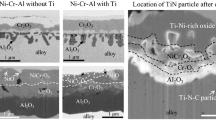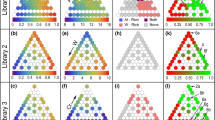Abstract
Adopting a high-throughput combinatorial approach, a compositionally graded Ti–xAl (0 ≤ x ≤ 8 wt%) specimen was prepared to conduct a rapid systematic investigation of the influence of composition and exposure time on the oxidation performance of the titanium-rich section of the binary Ti–Al system. The compositionally graded specimen was solution heat treated and subjected to oxidation tests at 650 °C for different exposure times. The morphology, structure, and composition of the oxide scale as well as the microstructural changes in the base material were studied across the entire composition range, using a suite of characterization techniques. The observations revealed the presence of Al2O3 in the topmost layer of the oxide scale in addition to TiO2, indicating its early formation during oxidation. An increase in Al concentration improves the scaling rate of Ti; however, this is observed only for extended exposure times (i.e., 50 and 100 h), and a parabolic oxidation law is obeyed in the composition-time domain. The formation of the α2 phase (Ti3Al) also takes place for relatively higher Al contents (i.e., 8 wt%).









Similar content being viewed by others
References
Rahmel A, Spencer PJ (1991) Thermodynamic aspects of TiAl and TiSi2 oxidation: the Al–Ti–O and Si–Ti–O phase diagrams. Oxid Met 35:53–68
Leyens C, Peters M (2006) Titanium and titanium alloys. Wiley, Weinheim
Appel F, Paul JDH, Oehring M (2011) Gamma titanium aluminide alloys: science and technology. Wiley, Weinheim
Ebach-Stahl A, Eilers C, Laska N, Braun R (2013) Cyclic oxidation behaviour of the titanium alloys Ti-6242 and Ti-17 with Ti–Al–Cr–Y coatings at 600 and 700 °C in air. Surf Coat Technol 223:24–31
Roy TK, Balasubramaniam R, Ghosh A (1996) High-temperature oxidation of Ti3Al-based titanium aluminides in oxygen. Metall Mater Trans A 27:3993–4002
Rahmel A, Schütze M, Quadakkers W (1995) Fundamentals of TiAl oxidation—a critical review. Mater Corros 46:271–285
Becker S, Rahmel A, Schorr M, Schütze M (1992) Mechanism of isothermal oxidation of the intel-metallic TiAl and of TiAl alloys. Oxid Met 38:425–464
Menzies I, Strafford K (1967) The scaling of binary alloys of titanium containing 5 wt% of aluminium, copper, or cobalt in carbon dioxide at 1000° C. J Less Common Metals 12:85–106
Menzies I, Strafford K (1967) A kinetic and morphological study of the oxidation of Ti-Cr alloys in CO2 at 1000 °C. Corros Sci 7:23–38
Shamblen C, Redden T (1970) Air contamination and embrittlement of titanium alloys. In: The science, technology and application of titanium, First International Conference on titanium, Jaffee RI, Promisel NE (ed), Pergamon Press, London, pp, 1967, p 199–208
Shida Y, Anada H (1993) Oxidation behavior of binary Ti–Al alloys in high temperature air environment. JIM, Mater Trans 34:236–242
Okamoto H (1993) Al–Ti (aluminum–titanium). J Phase Equilib 14(1):120–121
Lim J, McMahon C, Pope D, Williams J (1976) The effect of oxygen on the structure and mechanical behavior of Aged Ti-8 Wt pct Al. Metall Trans A 7:139–144
Grabke HJ, Schutze M (2008) Oxidation of intermetallics. Wiley, Weinheim
Zhang M-X, Hsieh K-C, DeKock J, Chang Y (1992) Phase diagram of Ti–Al–O at 1100 °C. Scripta metallurgica et materialia 27:1361–1366
Samimi P, Liu Y, Ghamarian I, Collins PC (2014) A novel tool to assess the influence of alloy composition on the oxidation behavior and concurrent oxygen-induced phase transformations for binary Ti–xMo alloys at 650 °C. Corros Sci 89:295–306
Samimi P, Liu Y, Ghamarian I, Brice DA, Collins PC (2015) A new combinatorial approach to assess the influence of alloy composition on the oxidation behavior and concurrent oxygen-induced phase transformations for binary Ti–xCr alloys at 650 °C. Corros Sci 97:150–160
Collings EW (1984) The physical metallurgy of titanium alloys. American Society for Metals, Metals Park
Lütjering G, Williams JC (2007) Titanium. Springer, Berlin
Jepson K, Brown A, Gray J (1970) Effect of cooling rate on the beta transformation in titanium-niobium and titanium-aluminium alloys. In: The science, technology, and application of titanium. Pergamon Press, London, p 677–690
Jacobson NS, Brady MP, Mehrotra GM (1999) Thermodynamics of selected Ti–Al and Ti–Al–Cr alloys. Oxid Met 52:537–556
Eckert M, Bencze L, Kath D, Nickel H, Hilpert K (1996) Thermodynamic activities in the alloys of the Ti–Al system. Ber Bunsenges Phys Chem 100:418–424
Kelkar GP, Carim AH (1995) Phase equilibria in the Ti–AI–O system at 945 °C and analysis of Ti/Al2O3 reactions. J Am Ceram Soc 78:572–576
Li XL, Hillel R, Teyssandier F, Choi SK, Van Loo FJJ (1992) Reactions and phase relations in the TiAlO system. Acta Metall Mater 40:3149–3157
Luthra KL (1991) Stability of protective oxide films on Ti-base alloys. Oxid Met 36:475–490
Brady MP, Pint BA, Tortorelli PF, Wright IG, Hanrahan Jr RJ (2008) High-temperature oxidation and corrosion of intermetallics. In: Materials science and technology: a comprehensive treatment, Weinheim: Wiley, p 229–325
Smialek J, Nesbitt J, Brindley W, Brady M, Doychak J, Dickerson R, Hull D (1994) Service limitations for oxidation resistant intermetallic compounds. In: MRS Proceedings, Cambridge Univ Press
Schütze M, Friedle S (2013) Oxidation behavior of intermetallic titanium aluminide alloys. In: MRS Proceedings, Cambridge Univ Press, p 77–88
Lang C, Schütze M (1996) TEM investigations of the early stages of TiAl oxidation. Oxid Met 46:255–285
Meier G, Pettit F, Hu S (1993) Oxidation behavior of titanium aluminides, Le Journal de Physique IV, 3:C9-395-C399-402
Roy TK, Balasubramaniam R, Ghosh A (1996) Effect of nitrogen on the oxidation behavior of Ti3Al-based intermetallic alloys. Metall Mater Trans A 27:4003–4010
Kaufman L, Bernstein H (1970) Computer calculation of phase diagrams with special reference to refractory metals. Academic press, New York
CompuTherm, LLC, Pandat 8.0-Phase Diagram Calculation Software for Multi-component Systems, CompuTherm LLC, Madison, WI, 53719 (2008)
Gubbels G, Heikinheimo L, Klomp J (1994) A comparison between titanium-alumina diffusion bonding and titanium active brazing. Zeitschrift für Metallkunde 85:828–832
Welsch G, Boyer R, Collings EW (1993) Materials properties handbook: titanium alloys. ASM International, Materials park
Yoshihara M, Tanaka R (1991) Oxidation resistance and its improvement in TiAl. Bull Jpn Inst Metals 30:61–65
Shida Y, Anada H (1991) Structure of oxide scale of binary Ti–Al alloys formed in high temperature air. Jpn Inst Metals J 55:690–695
Kofstad P (1972) Nonstoichiometry, diffusion, and electrical conductivity in binary metal oxides. Wiley-Interscience, New York
Siegel H, Duncan Jr R, Swift R (1955) Scaling of titanium and titanium alloys. In: DTIC document, p 54–109
Acknowledgements
This work was conducted within the NSF I/UCRC Center for Advanced Non-Ferrous Structural Alloys (CANFSA) which is a joint industry-university center between the Colorado School of Mines and the University of North Texas. The authors gratefully acknowledge the support of NSF (Award Number 1134873) and the support and active mentorship of the industrial partners. The authors also gratefully acknowledge the facilities available at the University of North Texas’ Center for Advanced Research and Technology (CART).
Author information
Authors and Affiliations
Corresponding author
Rights and permissions
About this article
Cite this article
Samimi, P., Brice, D.A., Banerjee, R. et al. On the influence of alloy composition on the oxidation performance and oxygen-induced phase transformations in Ti–(0–8) wt%Al alloys. J Mater Sci 51, 3684–3692 (2016). https://doi.org/10.1007/s10853-015-9681-x
Received:
Accepted:
Published:
Issue Date:
DOI: https://doi.org/10.1007/s10853-015-9681-x




